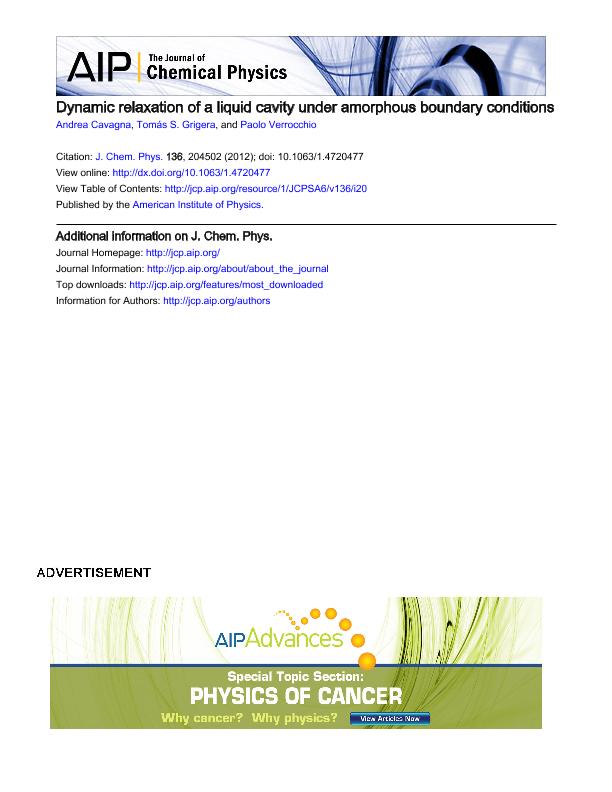Mostrar el registro sencillo del ítem
dc.contributor.author
Cavagna, A.
dc.contributor.author
Grigera, Tomas Sebastian

dc.contributor.author
Verrocchio, Paolo
dc.date.available
2019-08-21T14:05:37Z
dc.date.issued
2012-05-24
dc.identifier.citation
Cavagna, A.; Grigera, Tomas Sebastian; Verrocchio, Paolo; Dynamic relaxation of a liquid cavity under amorphous boundary conditions; American Institute of Physics; Journal of Chemical Physics; 136; 20; 24-5-2012; 1-16; 204502
dc.identifier.issn
0021-9606
dc.identifier.uri
http://hdl.handle.net/11336/81913
dc.description.abstract
The growth of cooperatively rearranging regions was invoked long ago by Adam and Gibbs to explain the slowing down of glass-forming liquids. The lack of knowledge about the nature of the growing order, though, complicates the definition of an appropriate correlation function. One option is the point-to-set (PTS) correlation function, which measures the spatial span of the influence of amorphous boundary conditions on a confined system. By using a swap Monte Carlo algorithm we measure the equilibration time of a liquid droplet bounded by amorphous boundary conditions in a model glass-former at low temperature, and we show that the cavity relaxation time increases with the size of the droplet, saturating to the bulk value when the droplet outgrows the point-to-set correlation length. This fact supports the idea that the point-to-set correlation length is the natural size of the cooperatively rearranging regions. On the other hand, the cavity relaxation time computed by a standard, nonswap dynamics, has the opposite behavior, showing a very steep increase when the cavity size is decreased. We try to reconcile this difference by discussing the possible hybridization between mode-coupling theory and activated processes, and by introducing a new kind of amorphous boundary conditions, inspired by the concept of frozen external state as an alternative to the commonly used frozen external configuration.
dc.format
application/pdf
dc.language.iso
eng
dc.publisher
American Institute of Physics

dc.rights
info:eu-repo/semantics/openAccess
dc.rights.uri
https://creativecommons.org/licenses/by-nc-sa/2.5/ar/
dc.subject
Liquid
dc.subject
Amorphous Boundary Conditions
dc.subject
Glassformer
dc.subject.classification
Física de los Materiales Condensados

dc.subject.classification
Ciencias Físicas

dc.subject.classification
CIENCIAS NATURALES Y EXACTAS

dc.title
Dynamic relaxation of a liquid cavity under amorphous boundary conditions
dc.type
info:eu-repo/semantics/article
dc.type
info:ar-repo/semantics/artículo
dc.type
info:eu-repo/semantics/publishedVersion
dc.date.updated
2019-05-03T17:34:06Z
dc.journal.volume
136
dc.journal.number
20
dc.journal.pagination
1-16; 204502
dc.journal.pais
Estados Unidos

dc.description.fil
Fil: Cavagna, A.. Università Sapienza. Dipartimento di Fisica; Italia. Consiglio Nazionale delle Ricerche; Italia
dc.description.fil
Fil: Grigera, Tomas Sebastian. Consejo Nacional de Investigaciones Científicas y Técnicas. Centro Científico Tecnológico Conicet - La Plata. Instituto de Investigaciones Fisicoquímicas Teóricas y Aplicadas. Universidad Nacional de La Plata. Facultad de Ciencias Exactas. Instituto de Investigaciones Fisicoquímicas Teóricas y Aplicadas; Argentina
dc.description.fil
Fil: Verrocchio, Paolo. Università degli Studi di Trento; Italia. Interdisciplinary Laboratory for Computational Physics; Italia. Instituto de Biocomputación y Física de Sistemas Complejos; España
dc.journal.title
Journal of Chemical Physics

dc.relation.alternativeid
info:eu-repo/semantics/altIdentifier/doi/http://dx.doi.org/10.1063/1.4720477
dc.relation.alternativeid
info:eu-repo/semantics/altIdentifier/url/https://aip.scitation.org/doi/10.1063/1.4720477
Archivos asociados
